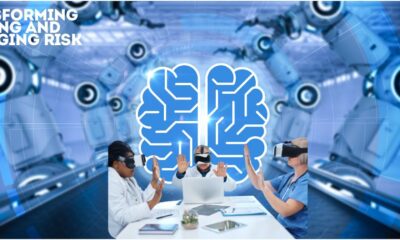Automotive
Autonomous Driving Technology: The Road Ahead

Autonomous driving technology is rapidly evolving, promising to transform the way we travel. As we explore the advancements in self-driving cars, we also need to consider the safety, ethical, and societal implications that come with this innovation. This article delves into the key aspects of autonomous vehicles, their impact on our lives, and the challenges that lie ahead.
Key Takeaways
- Self-driving cars use advanced sensors to navigate and avoid obstacles, aiming to reduce accidents caused by human error.
- The technology is still developing, with ongoing challenges in safety and ethics that must be addressed before widespread adoption.
- Public acceptance is crucial for the success of autonomous vehicles, requiring education and transparency about their benefits and risks.
- Collaboration between industry and academia is essential for advancing research and development in autonomous driving technology.
- Legal frameworks and insurance models are needed to clarify liability and safety regulations for self-driving cars.
The Evolution of Autonomous Driving Technology
Historical Milestones in Self-Driving Cars
The journey of self-driving cars began in the 1920s with the first radio-controlled vehicle. By the 1980s, significant advancements were made with the development of the first autonomous vehicle, which could navigate a course without human intervention. Here are some key milestones:
- 1920s: First radio-controlled car.
- 1980s: The first autonomous vehicle, "Navlab".
- 2000s: DARPA Grand Challenge spurs innovation.
Key Innovations in Autonomous Vehicles
Several innovations have propelled autonomous driving technology forward. These include:
- Sensor technologies: Cameras, LIDAR, and radar help vehicles understand their surroundings.
- Artificial intelligence: Machine learning algorithms enable cars to make decisions based on data.
- Connectivity: Vehicles can communicate with each other and infrastructure for safer navigation.
Pioneers in Autonomous Driving
Many companies and individuals have played crucial roles in advancing autonomous driving technology. Some notable pioneers include:
- Waymo: A leader in self-driving technology, originally part of Google.
- Tesla: Known for its innovative Full Self-Driving (FSD) software.
- Cruise: A company focused on developing autonomous taxis.
The evolution of autonomous driving technology is not just about the cars themselves; it’s about creating a safer and more efficient future for everyone on the road.
This technology continues to evolve, promising a future where self-driving cars could become a common sight on our roads, transforming how we travel and interact with our environment.
Safety and Ethical Considerations in Autonomous Driving
Addressing Safety Concerns
The safety of autonomous vehicles (AVs) is a major topic of discussion. Many believe that self-driving cars can significantly reduce accidents caused by human error. However, there are still many challenges to overcome. For instance:
- Technical issues: Software glitches can lead to dangerous situations.
- Data management: AVs need vast amounts of mapping data to navigate safely.
- Real-world testing: More driving experience is essential to improve safety.
Ethical Dilemmas in Autonomous Driving
As AV technology advances, ethical questions arise. Key dilemmas include:
- Decision-making in emergencies: How should a car react in a life-threatening situation?
- Privacy concerns: How is data collected and used?
- Accountability: Who is responsible if an AV causes an accident?
Regulatory and Legal Challenges
The legal landscape for AVs is still developing. Important aspects include:
- Liability issues: Determining who is at fault in accidents involving AVs.
- Insurance models: Adapting insurance to cover self-driving cars.
- Regulatory frameworks: Establishing rules to ensure safety and accountability.
The path to safe and ethical autonomous driving requires collaboration between technology developers, regulators, and the public. Transparency and accountability are essential to build trust in this emerging technology.
In summary, while autonomous vehicles hold great promise for improving road safety, addressing safety and ethical concerns is crucial for their successful integration into society.
Technological Foundations of Autonomous Vehicles
Sensor Technologies and Their Roles
Self-driving cars rely on various sensors to understand their surroundings. These include:
- Cameras: Capture visual data to identify objects like pedestrians and traffic signals.
- Lidar: Uses laser light to create a 3D map of the environment.
- Radar: Detects the speed and distance of nearby objects.
These technologies work together to help the vehicle navigate safely.
Artificial Intelligence in Self-Driving Cars
Artificial intelligence (AI) is crucial for processing the data collected by sensors. It helps the car make decisions based on:
- Real-time data analysis: Understanding the environment as it changes.
- Learning from experience: Improving performance through past driving scenarios.
- Predictive modelling: Anticipating the actions of other road users.
AI enables vehicles to react quickly and safely in complex situations.
The Importance of 3D Mapping
3D mapping is essential for autonomous vehicles to operate effectively. It provides:
- Detailed road layouts: Helping cars understand where they are.
- Information on obstacles: Identifying potential hazards in the environment.
- Navigation support: Ensuring accurate route planning.
The integration of these technologies is vital for the safe operation of autonomous vehicles. As the adaptive cruise control market grows, it highlights the increasing demand for advanced driver assistance systems, which are foundational for full autonomy.
In summary, the technological foundations of autonomous vehicles are built on a combination of sensor technologies, AI, and detailed mapping, all working together to create a safer driving experience.
Impact of Autonomous Vehicles on Society
Transformations in Urban Design
The introduction of autonomous vehicles (AVs) is set to change how cities are designed. Urban spaces will be reimagined to accommodate these vehicles, leading to:
- Reduced need for parking spaces
- Wider pedestrian areas
- Enhanced public transport systems
Changes in Daily Commuting
AVs promise to revolutionise daily travel. Commuters may experience:
- Increased convenience with on-demand transport
- Reduced travel times due to optimised routes
- Less stress as driving responsibilities shift to the vehicle
Economic Implications of Self-Driving Cars
The economic landscape will also shift with the rise of AVs. Key impacts include:
- Job creation in tech and maintenance sectors
- Potential job losses in traditional driving roles
- Changes in the automotive supply chain management, as companies adapt to new technologies and demands
The shift to autonomous vehicles is not just about technology; it’s about reshaping our lives and communities.
As we look ahead, the societal impacts of AVs will be profound, influencing everything from urban planning to daily routines and economic structures.
Challenges in Achieving Full Autonomy

Technical Hurdles in Autonomous Driving
Achieving full autonomy in vehicles is not just about having the right technology; it involves overcoming several technical challenges. These include:
- Complex software systems that must be flawless to prevent accidents.
- High-quality 3D mapping that is essential for navigation.
- Robust sensor technologies that can accurately detect and respond to various road conditions.
Human-Machine Interaction Issues
Another significant challenge is how humans interact with autonomous vehicles. This includes:
- Trust: People need to trust that self-driving cars will make safe decisions.
- Understanding: Users must understand how these vehicles operate to feel comfortable.
- Control: There should be clear guidelines on when and how a human can take control if needed.
The Role of Real-World Testing
Real-world testing is crucial for the development of autonomous vehicles. It helps in:
- Gathering data from diverse driving scenarios.
- Identifying potential issues that may not appear in simulations.
- Ensuring that vehicles can handle unexpected situations effectively.
The journey to full autonomy is filled with obstacles, but overcoming these challenges is essential for the future of transportation.
In summary, while the potential of autonomous vehicles is immense, addressing these challenges is vital for their successful integration into society. Safety, trust, and effective testing are key components that need to be prioritised as we move forward.
The Future of Autonomous Driving Technology
Predictions for the Next Decade
The next ten years are expected to bring significant advancements in autonomous driving technology. Experts predict that:
- More vehicles will be equipped with advanced driver assistance systems (ADAS).
- The market for adaptive front lighting is projected to reach US$ 2.3 billion by 2032, driven by the demand for enhanced safety features.
- Regulations will evolve to accommodate the growing presence of self-driving cars on the roads.
Potential Benefits and Risks
While the future looks promising, there are both benefits and risks to consider:
- Increased safety: Autonomous vehicles could drastically reduce traffic accidents caused by human error.
- Economic growth: The rise of self-driving technology may create new jobs and industries.
- Privacy concerns: The data collected by these vehicles could lead to potential misuse.
The journey towards fully autonomous vehicles is not just about technology; it’s about reshaping our society and how we interact with transportation.
The Road to Mainstream Adoption
Achieving widespread acceptance of autonomous vehicles will require:
- Public education on the benefits and safety of self-driving cars.
- Collaboration between tech companies, governments, and the public to create a supportive infrastructure.
- Continuous improvement in technology to ensure reliability and safety in diverse driving conditions.
In conclusion, the future of autonomous driving technology holds great promise, but it will require careful navigation of both opportunities and challenges to reach its full potential.
Global Perspectives on Autonomous Driving
Autonomous Vehicle Initiatives Worldwide
Countries around the globe are exploring autonomous vehicle initiatives to enhance transportation. Here are some notable examples:
- United States: Major companies like Waymo and Tesla are leading the charge in self-driving technology.
- China: Rapid advancements in AV technology, with significant government support and investment.
- Europe: Countries like Germany and the UK are developing regulatory frameworks to facilitate AV testing and deployment.
Comparative Analysis of Regional Approaches
Different regions have unique strategies for implementing autonomous vehicles. A comparison reveals:
| Region | Approach | Key Focus Areas |
|---|---|---|
| North America | Innovation-driven | Safety, technology, and regulation |
| Asia | Government-led initiatives | Infrastructure and investment |
| Europe | Collaborative frameworks | Public acceptance and safety |
International Collaboration and Competition
The race for autonomous driving technology is not just about competition; it also involves collaboration. Key points include:
- Shared Research: Countries are pooling resources for research and development.
- Standardisation: Efforts to create global standards for AV technology.
- Cross-Border Testing: Collaborative testing initiatives to ensure safety and efficiency.
The future of autonomous driving is a convergence of technology and standards to meet human expectations about how a driverless vehicle should operate.
In summary, the global landscape of autonomous driving is marked by diverse initiatives, regional strategies, and a blend of competition and collaboration. As countries navigate the complexities of this technology, the path forward will require careful consideration of safety, regulation, and public acceptance.
Public Perception and Acceptance of Autonomous Vehicles

Public Opinion on Self-Driving Cars
The acceptance of self-driving cars varies widely among the public. Many people are excited about the potential benefits, while others are concerned about safety and reliability. Recent surveys show:
- 40% of respondents are enthusiastic about AVs.
- 30% express concerns about safety.
- 20% are unsure about the technology.
Influence of Media on Perception
Media plays a significant role in shaping public views on autonomous vehicles. Positive coverage can boost acceptance, while negative stories can create fear. Key factors include:
- News reports on accidents involving AVs.
- Documentaries showcasing the technology’s benefits.
- Social media discussions influencing opinions.
Strategies to Increase Acceptance
To improve public acceptance of autonomous vehicles, several strategies can be employed:
- Education campaigns to inform the public about AV safety.
- Demonstration events allowing people to experience AVs firsthand.
- Engagement with communities to address concerns and gather feedback.
Understanding public perception is crucial for the successful integration of autonomous vehicles into society. Addressing fears and misconceptions can pave the way for a smoother transition to this new technology.
Economic and Environmental Benefits of Autonomous Vehicles
Reduction in Traffic Accidents
One of the most significant advantages of autonomous vehicles is their potential to enhance road safety. With advanced technology, these vehicles can significantly lower the number of accidents on the roads. Studies suggest that AVs could reduce traffic accidents by up to 90%. This reduction not only saves lives but also decreases the costs associated with accidents, such as medical expenses and vehicle repairs.
Environmental Impact of Self-Driving Cars
The environmental benefits of autonomous vehicles are also noteworthy. They can lead to:
- Lower emissions due to more efficient driving patterns.
- Reduced traffic congestion, which means less time spent idling in traffic.
- Increased use of electric vehicles, as many AVs are designed to be electric.
| Benefit | Impact |
|---|---|
| Reduction in Traffic Accidents | Up to 90% decrease in accidents |
| Lower Emissions | Significant reduction in CO2 |
| Increased Mobility | Better access for disabled users |
Economic Gains from Autonomous Technology
The economic implications of AVs are vast. They can lead to:
- Job creation in tech and automotive sectors.
- Cost savings for individuals and businesses through reduced insurance premiums and lower vehicle ownership costs.
- Increased productivity, as people can use travel time for work or leisure instead of driving.
The shift to autonomous vehicles promises not only to transform transportation but also to create a safer and more efficient environment for everyone.
The Role of Industry and Academia in Advancing Autonomous Driving
Collaborations Between Universities and Companies
The partnership between universities and industry is crucial for the development of autonomous vehicles. These collaborations help in:
- Sharing knowledge and resources.
- Conducting joint research projects.
- Providing students with real-world experience.
Research and Development Efforts
Research institutions are at the forefront of innovation in autonomous driving. They focus on:
- Developing new algorithms for better decision-making.
- Enhancing sensor technologies for improved perception.
- Addressing safety concerns through rigorous testing.
Case Studies of Successful Partnerships
Several successful partnerships illustrate the benefits of collaboration:
- USC’s Centre for Autonomy and AI works with companies like Toyota and Siemens to tackle industry challenges.
- These partnerships have led to advancements in corner case handling, which is essential for safe autonomous driving.
- The integration of foundation models in research has shown promise in improving vehicle performance in complex scenarios.
The collaboration between academia and industry is vital for overcoming the challenges in autonomous driving technology. By working together, they can create solutions that benefit everyone.
Legal and Insurance Implications of Autonomous Vehicles
Liability Issues in Autonomous Driving
Determining liability in accidents involving autonomous vehicles (AVs) is complex. Key questions include:
- Who is responsible if an AV causes an accident?
- Is it the manufacturer, the software developer, or the owner?
- How do we assess fault in a system that operates independently?
Insurance Models for Self-Driving Cars
The rise of AVs necessitates new insurance models. Traditional car insurance may not suffice. Potential models include:
- Usage-based insurance: Charges based on how much the vehicle is used.
- Manufacturer liability insurance: Manufacturers cover damages caused by their vehicles.
- Shared insurance: Coverage for fleets of AVs used by multiple users.
Regulatory Frameworks and Policies
Establishing effective regulatory frameworks is crucial for the safe integration of AVs. Important considerations include:
- Setting standards for AV safety and performance.
- Creating guidelines for data privacy and security.
- Ensuring compliance with traffic laws and regulations.
The transition to autonomous vehicles will require a collaborative effort between governments, manufacturers, and insurers to create a safe and effective environment for all road users.
| Aspect | Current Status | Future Considerations |
|---|---|---|
| Liability | Unclear, varies by jurisdiction | Need for standardisation |
| Insurance Models | Traditional models in use | Development of new models |
| Regulatory Frameworks | Fragmented, varies by region | Comprehensive global standards needed |
Conclusion
In summary, the journey towards fully autonomous vehicles is both exciting and challenging. As technology continues to advance, self-driving cars are becoming more capable of navigating our roads safely. They promise to reduce accidents caused by human mistakes, which is a significant benefit. However, there are still many hurdles to overcome, such as ensuring the technology is reliable and creating the right laws to support it. While we may not see fully self-driving cars everywhere just yet, the progress being made suggests that they will soon be a common sight. The future of transport is changing, and it holds great potential for making our lives easier and safer.
Frequently Asked Questions
What are autonomous vehicles?
Autonomous vehicles, or self-driving cars, are cars that can drive themselves without needing a human driver. They use technology like sensors and cameras to see their surroundings.
How do self-driving cars work?
Self-driving cars use a mix of sensors, cameras, and computer systems to understand the road and make decisions, similar to how a human driver would.
Are autonomous vehicles safe?
While self-driving cars are designed to be safer than regular cars, they still face challenges. They need to be tested a lot to ensure they can handle all kinds of situations.
What are the benefits of self-driving cars?
Self-driving cars can reduce traffic accidents, make travel easier for people who can’t drive, and might help improve traffic flow.
What challenges do autonomous vehicles face?
Self-driving cars face challenges like complex road conditions, legal issues, and the need for detailed maps to navigate safely.
How will autonomous vehicles change cities?
With more self-driving cars, cities might need fewer parking spaces, and urban design could shift to make room for more green spaces and public areas.
What is the future of autonomous driving technology?
The future looks promising, with many experts believing that self-driving cars will become more common in the next decade, but there are still hurdles to overcome.
How can I learn more about self-driving cars?
You can read articles, watch videos, and follow news on technology and transportation to learn more about self-driving cars and their development.
-

 Press Release6 days ago
Press Release6 days agoGlobal Compound Feeds and Additives Industry Report: Market Expansion and Competitive Insights to 2035
-

 Technology6 days ago
Technology6 days agoWhat to Know Before Switching Cell Phone Network Services in 2025
-

 Press Release5 days ago
Press Release5 days agoCrypto WINNAZ Launches First On-Chain Yield Engine for Meme Coins, Enabling 20x–300x Returns
-

 Press Release2 days ago
Press Release2 days agoBellarium ($BEL) Price Prediction: Could It Hit $5 by 2026?
-

 Press Release2 days ago
Press Release2 days agoWhy Alaxio (ALX) Is a Top Pick for Smart Crypto Investors
-

 Business1 day ago
Business1 day agoHow Managed IT Solutions Help Small Teams Compete at Enterprise Scale
































